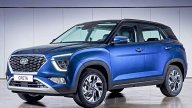Hyundai Kona vs. Hyundai Creta - In Images
Hyundai's B-SUVs compared visually and technically.
After weeks of teasing and months of test mule sightings, the Hyundai Kona has finally debuted. Here's a comparison between the Hyundai Kona and Hyundai Creta that answers why Hyundai offers two models in the same segment.

The Hyundai Kona and Hyundai Creta fall in the same segment but were designed for different customers. The Hyundai Creta is targeted largely at the emerging markets India, China, Russia, Brazil, Argentina and so on. Looks, pricing and value for money from basic features are the significant factors for this model's success in most markets. The Creta is designed with the ruggedness of a traditional SUV.
The Hyundai Kona is targeted at the developed markets USA, Canada, UK, Germany, France, Australia, Korea and more. The Hyundai Creta with its conservative design, basic safety and lack of advanced features would face rejection in the developed world, and the Hyundai Kona was thus born. The Hyundai Kona is designed dramatically, and every inch has a typical European appeal to it. The fact that this sub-compact SUV debuts the South Korean automaker's next-gen SUV design direction says enough about its importance for the brand. Usually, the flagship models bring in the new design language, which gradually flows down to the model lines.

The Hyundai Creta measures 4,270 mm in length, 1,780 mm in width and 1,630 mm in height, and has a wheelbase of 2,590 mm. The Hyundai Kona is 4,165 mm long, 1,800 mm wide and 1,550 mm tall. Despite 95 mm shorter, the Kona's wheelbase spans 2,600 mm, 10 mm more than the Creta's.
The Hyundai Creta's list of features tops out with bi-functional projector headlamps with LED positioning lamps, 17-inch wheels, 7.0-inch touchscreen infotainment system with Apple CarPlay, Android Auto, MirrorLink and rear-view camera, automatic climate control and leather seats. Six airbags, HAC, ESC and VSM, are the main safety features.

The Hyundai Kona, positioned as a relatively more premium product in the company's line-up, will sell with more appealing equipment. LED daytime running lights, LED headlights, 18-inch wheels, head-up display, 8.0-inch touchscreen infotainment system with satellite navigation, Apple CarPlay, Android Auto, HD Radio (North America)/ DAB digital radio (Europe), rear-view camera and 4G connectivity and wireless charging are the B-SUV's highlights. Forward Collision-Avoidance Assist, Lane Keeping Assist, Driver Attention Warning, Blind-Spot Collision Warning and Rear Cross-Traffic Collison Warning are the talking points of its safety. The body structure of the Kona is superior to the Creta's, Hyundai says the frame has been developed with 51.8% Advanced High Strength Steel to deliver "class-leading levels of passive safety."
The Hyundai Creta originated from the Hyundai ix25 sold in China. Only in China, there's an option for the 117.7 kW (157.77 hp) 1.6-litre T-GDI turbocharged petrol engine. Elsewhere, buyers get to choose from 1.6- and 2.0-litre naturally aspirated petrol engines and 1.4- and 1.6-litre turbocharged diesel engines. In Brazil, the petrol engines are ethanol-compliant. 6-speed manual, 6-speed automatic and 7-speed dual clutch automatic (China only) are the transmission choices, and there is an option for a four-wheel drive system in select regions.

Also See: 2017 Hyundai i20 Active (facelift) – Rendering
The Hyundai Kona, except one engine, is available exclusively with turbocharged units. The naturally aspirated mill is the 2.0-litre MPi unit that produces 149 PS and 179 Nm of torque. Other petrol engine options include the 1.0-litre T-GDI turbocharged mill (120 PS/172 Nm) and the 1.6-litre T-GDI turbocharged unit (177 PS/265 Nm). The 1.6-litre eVGT turbocharged engine producing 136 PS and 27.0 kgf.m (300.08 Nm) of torque is the sole option for those preferring diesel. 6-speed manual, 6-speed automatic and 7-speed dual-clutch automatic are the transmission choices. Kona buyers too will have an option for a four-wheel drive system.
In all likeliness, the Hyundai Kona will not sell in most markets where the Hyundai Creta is on duty. The Toyota C-HR rival will go on sale in South Korea at the end of this month. It will reach Europe in August, followed by the U.S. in December 2017.









